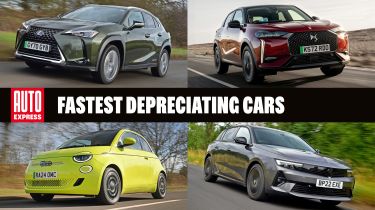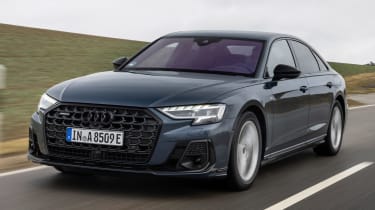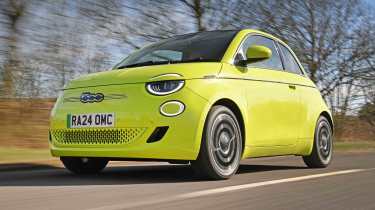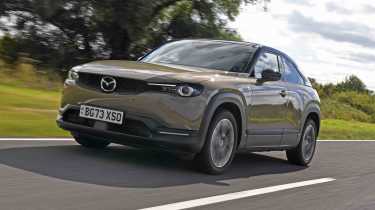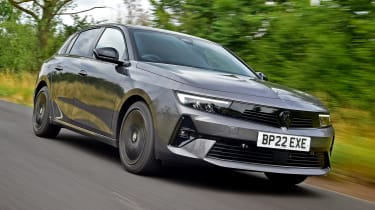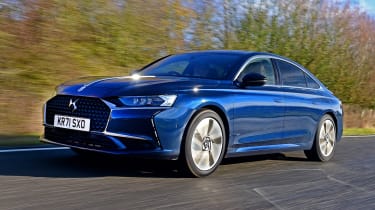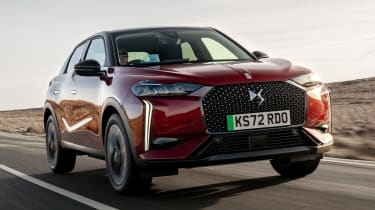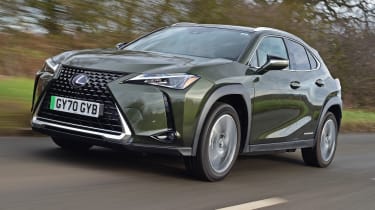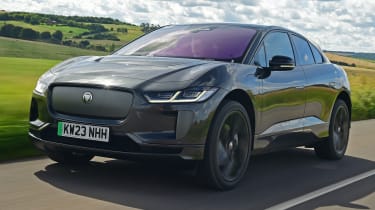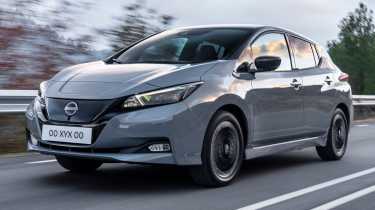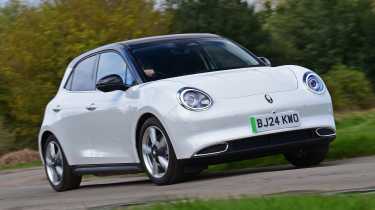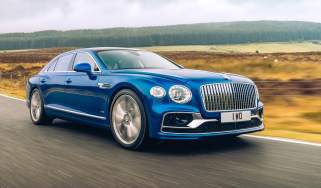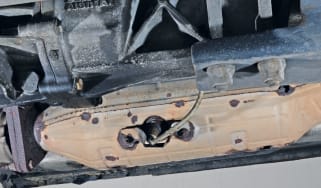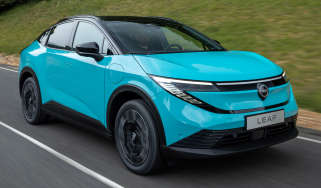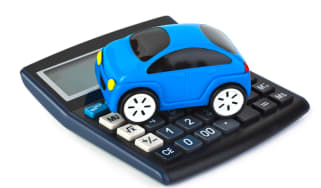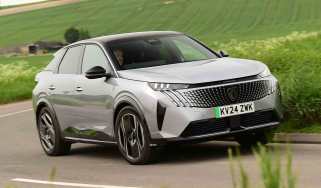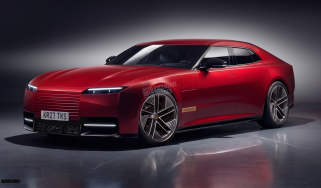Fastest depreciating cars: top 10 worst motoring money pits
Almost every new car depreciates, but some shed value faster than others. These are the top 10 fastest depreciating cars on sale today
Forget fuel, road tax or insurance, the biggest cost of running a car is depreciation, otherwise known as the difference between the on-the-road price you pay to buy the car when new and the figure you can recoup when selling it to its next owner.
That second-hand price is also known as the car’s residual value, and if you’re not careful it can be a real sting in the tail of any new or used car deal. Here we’re looking at the fastest depreciating cars on the market, both in terms of percentage retained value and total value lost.
To help you avoid mobile money-pits, we’ve combed the latest new car depreciation data to create a list of possible new car purchases with the biggest sting in the tail - the UK's fastest depreciating cars.
Our list, compiled with expert UK market analysis data, covers cars that you can buy new today and looks at what they will be worth after three years and 36,000 miles of use. These are the disastrous depreciators that experts say you shouldn’t touch with a bargepole, if you want to hang on to your cash. Of course, look at it another way and these cars could be opportunities for the canny used buyer to pick-up a three-year old bargain.
All kinds of market factors have a say in car residual values. Just as rare cars or those with long waiting lists can have very slow depreciation, heavy discounting or abundant supply will usually force values down. Electric cars make-up a large part of the current fastest depreciating top 10 with increasing supply and choice on the market, falling new prices and discounting by manufacturers needing to comply with the ZEV mandate all having an impact.
The 10 fastest depreciating cars in the UK
Now scroll down to read more about the models that make the top 10, according to our expert data
10. Audi A8
- Variant: 60 TFSIe
- Retained value: 30.74%
- Average new price: £103,275
- Average retained value: £31,750
Luxury car for the price of a new high-end supermini, anyone? That’s what those buying a three-year old Audi A8 will get, given it’ll be worth little more than 30 per cent of its original price after that period. There’s very little wrong with the car itself, but compared to their smaller counterparts, big German luxury saloons have always depreciated quickly, with owners only too happy to trade into new models after a few years, and used buyers hesitant to take on the hefty fuel and maintenance bills that a car like this can spring up. The A8 may only be the tenth fastest-depreciating car, but it holds the dubious honour of having the largest single drop in monetary value of any car in the top ten, losing more than £71,000 – similar to the drop in value of the next three cars combined
9. Fiat 500e
- Variant: 42kWh Giorgio Armani
- Retained value: 30.68%
- Average new price: £33,985
- Average retained value: £10,425
In the market for an urban runaround? Tempting though a brand new Dacia Spring is, surely a used Fiat 500e worth less than a third of its original value is an even better deal. It’s certainly more stylish, better to drive, and feels higher quality.
The price Fiat charges for a new 500e has always seemed a little steep, but at little more than ten grand (for the luxurious Armani “collector’s edition” in this case, with a set of impressively fancy Armani logo wheels) it’s hard to ignore. This 42kWh version has a claimed range of 200 miles too, and has the peppier 116bhp motor for 0-62mph in nine seconds flat
8. Mazda MX-30
- Variant: Prime-Line
- Retained value: 30.44%
- Average new price: £28,005
- Average retained value: £8,525
It’s a nice car, the Mazda MX-30, but a severely compromised one. That 35.5kWh battery pack means a claimed range of only 124 miles, which is at odds with the somewhat practical crossover shape, and how nice the MX-30 is to drive. It’s a real shame that any more than local commuting use would end up requiring multiple charging stops.
That and the love-hate “freestyle” rear-hinged rear doors make it an acquired taste, which might explain why you can get a three-year old one for little more than eight grand, cheaper than most used superminis
7. Vauxhall Astra
- Variant: 1.6 Plug-in-Hybrid Ultimate
- Retained value: 29.24%
- Average new price: £42,830
- Average retained value: £12,525
The Vauxhall Astra’s relatively high initial price in plug-in-hybrid form can’t help its depreciation; you’d have to be committed to the griffin badge to want to spend more than forty grand on one, low monthly payments or not.
As a used buy though it’s a bit of a steal, thanks to dropping more than 70 per cent of its value in three years. You might expect a twelve grand family hatch to be a bit ropey and perhaps five or six years old, but here’s a well-built three-year old car with a smart interior, decent performance (the plug-in makes 178bhp and gets to 62mph in under eight seconds), and compelling fuel economy. The plug-in goes 43 miles on its small battery, and should achieve in the 40-50mpg range once the electrons run out
Latest used Vauxhall Astra deals
6. DS Automobiles DS9
- Variant: 1.6 E-Tense Opera
- Retained value: 28.90%
- Average new price: £64,800
- Average retained value: £18,725
Given “French luxury car” has been the secret password to epic depreciation since at least the 1990s, it’s almost impressive that the DS 9, of which DS Automobiles sells just a handful each year, is only mid-table in our fastest depreciation list.
Losing well over £40k in three years has to sting a bit, but if you want a relatively handsome, well-appointed car that isn’t an SUV and isn’t German (a diminishing list, it has to be said) then a sub-£20k DS 9 begins to look curiously appealing. Give it another decade and the kind of French car enthusiasts who currently clamour for Renault Avantimes and Citroen C6s will be tripping over each other for three-grand DS 9s
5. DS Automobiles DS3 E-Tense
- Variant: 54kWh Pallas
- Retained value: 28.88%
- Average new price: £39,210
- Average retained value: £11,325
If you’re using this article as a shopping list for your next used family car, then here’s another to consider: a three-year old DS3 E-Tense will set you back only £11,000 on average, around 29% of what it cost when new. The DS3’s far from the best compact electric SUV you can buy today but given that its high new pricing is one of the less appealing things about it, that’s a rather large barrier removed for used buyers. The 54kWh model here has a claimed 250-mile range, and it’s a refined drive with an attractive, if slightly confusing, dashboard layout
4. Lexus UX-e
- Variant: 300e 72.8kWh Takumi
- Retained value: 28.55%
- Average new price: £51,145
- Average retained value: £14,600
It’s unusual to see a Lexus among the fastest-depreciating cars – the brand’s reputation for reliability, high quality, and relatively low supply mean used Lexus are always in demand and tend to hold onto their value. Not even Lexus can escape the hefty depreciation felt by a lot of electric cars though, with the UX 300e in top-line Takumi spec (high trim levels are another surefire way to shed value) dropping from more than £50,000 to under £15,000 after three years.
That’s Dacia Spring money for a luxury SUV the size of a Toyota C-HR. When we ran a UX 300e long-term, we found the official 196-mile range only dropped to around 180 miles even in cold weather, albeit in predominantly urban use
3. Jaguar I-Pace
- Variant: 90kWh 400 R-Dynamic S
- Retained value: 27.97%
- Average new price: £69,995
- Average retained value: £19,575
Whatever Jaguar pulls out of the hat with its upcoming rebrand and the imposing Type 00 luxury vehicle it plans to sell in 2026, customers will be hoping for better residuals than for the company’s outgoing electric car. The Jaguar I-Pace was ahead of the curve with luxury EVs but the competition caught up quickly, and the car’s 292-mile range has been overtaken by some much humbler vehicles. That might be why an I-Pace is worth less than 28 per cent of its new value after three years – though the prospect of a three-year old model for under £20,000 is much more appealing for used buyers
Latest used Jaguar I-Pace deals
2. Nissan Leaf
- Variant: 39kWh Acenta
- Retained value: 26.54%
- Average new price: £29,290
- Average retained value: £7,775
Nissan recently launched an all-new Nissan Leaf, which has taken on a distinctly SUV-shaped form. The outgoing car was a lot more conventional; indeed, it was about as conventional as EVs get, being a standard Golf-sized family hatch that happened to be battery-powered. That the price never came down a huge amount to account for a modest 239-mile range meant it hasn’t really stood out in recent years against the barrage of new EVs hitting the market. But the original buyer’s (or finance company’s) loss is your gain, as a three-year old Leaf for under £8,000 seems like a pretty good deal
1. GWM Ora 03
- Variant: 48kWh Pure+
- Retained value: 25.79%
- Average new price: £31,995
- Average retained value: £8,250
The Chinese car industry is catching up fast with European brands, and some might say it’s overtaken Europe in several areas. It hasn’t escaped electric car depreciation, however, if the GWM Ora 03 (formerly Ora Funky Cat) is any indication. That’s because for a car that cost nearly £32k new, you can expect the Ora 03 to be worth little more than eight grand after three years. With buyers not exactly clamouring for this oddly-styled vehicle from an unfamiliar brand, expect it to be even cheaper given another year or two on the market.
Top 10 fastest depreciating cars in the UK
- GWM Ora 03
- Nissan Leaf
- Jaguar I-Pace
- Lexus UX-e
- DS 3
- DS 9
- Vauxhall Astra
- Mazda MX-30
- Fiat 500e
- Audi A8
What makes a car depreciate fast?
As you’d expect, the slowest depreciating cars are models in strong demand, with desirable badges and good reputations for reliability, quality and safety. They are discounted less than rivals when new, and hold their money at resale time.
Strangely, the worst depreciators often have highly desirable badges too, but their new prices are just too stratospheric to do anything but plummet when it’s time to find a second owner. Bread and butter models from mainstream brands whose badges offer little in the way of aspirational value, and whose reputations for quality or performance are not in the same league as models from the ‘in demand’ brands, can suffer too.
People like to joke about cars losing half their value the moment they’re driven off the forecourt but that’s rarely actually the case. Even the worst performers will take a couple of years or more to lose half their value, while some rare, exotic or limited production models may even rise in value – or appreciate – but, of course, that’s not the experience for most new car buyers.
Still, there’s a vast range of depreciation performance across the new car spectrum. Typically a strong performer will lose less than half of its value over a three-year/36,000-mile ownership cycle, with the slowest depreciating cars still worth 60-70 per cent of what you paid for them. Conversely, a poor depreciator can easily lose 50-60 per cent of its on-the-road price over the same timeframe.
Remember that all depreciation is calculated based on the car’s official list price and if dealers are offering heavy discounts on a car, the depreciation figures will look bad but very few people will actually be paying that much to buy new. Plus, depreciation is a cost that only crystallises when you sell the car. If you hold on to it for longer it isn’t a concern.
Why are some electric car residual values so low?
In the UK, the Zero-Emission Vehicle (ZEV) mandate means that manufacturers are now legally required to sell a rising proportion of fully-electric cars every year up until 2030, when this number will reach 100 per cent.
In order to meet these percentage targets, brands are increasingly resorting to discounting or long-term price cuts to help boost sales of EVs. Then there’s the government Electric Car Grant applied to models at the cheaper end of the market. Naturally, these discounted new cars create pressure on values of electric cars on the used market further down the line.
In addition to this, the rapid development of EV technology and the expanding amount of choice for consumers means that some older models can start to feel dated quite quickly, thus reducing their appeal to car buyers compared to new alternatives. And it’s not all EVs that have a depreciation issue, some of the more popular and competitively priced options hold their value very well.
Car depreciation: the worst of the rest
Our list of the top 10 fastest depreciating cars includes a heady mix of the overpriced, the unfashionable and the unremarkable. If you look further down the charts there’s more of the same, as well as some surprises.
| Rank | Model | Average new price | Average part-ex value (3 years/36,000 miles) | Average retained value (3 years/36,000 miles) |
| 1 | GWM Ora 03 48kWh Pure+ | £31,995.00 | £8,250.00 | 25.79% |
| 2 | Nissan Leaf 39kWh Acenta | £29,290.00 | £7,775.00 | 26.54% |
| 3 | Jaguar I-Pace 90kWh 400 R-Dynamic S | £69,995.00 | £19,575.00 | 27.97% |
| 4 | Lexus UX-e 300e 72.8kWh Takumi | £51,145.00 | £14,600.00 | 28.55% |
| 5 | DS Automobiles DS3 E-Tense 54kWh Pallas | £39,210.00 | £11,325.00 | 28.88% |
| 6 | DS Automobiles DS9 1.6 E-Tense Opera | £64,800.00 | £18,725.00 | 28.9% |
| 7 | Vauxhall Astra 1.6 Plug-in-Hybrid Ultimate | £42,830.00 | £12,525.00 | 29.24% |
| 8 | Mazda MX-30 Prime-Line | £28,005.00 | £8,525.00 | 30.44% |
| 9 | Fiat 500e 42kWh Giorgio Armani | £33,985.00 | £10,425.00 | 30.68% |
| 10 | Audi A8 60 TFSIe | £103,275.00 | £31,750.00 | 30.74% |
| 11 | Vauxhall Corsa-e 51kWh 156 GS | £32,635.00 | £10,100.00 | 30.95% |
| 12 | KGM Korando eMOTION 61.5kWh 207 ELX | £33,995.00 | £10,700.00 | 31.48% |
| 13 | Honda e 35.5kWh 154 Advance | £38,345.00 | £12,325.00 | 32.14% |
| 14 | BMW 8 Series Coupe 840i | £87,120.00 | £28,050.00 | 32.2% |
| 15 | Peugeot E-3008 73kWh 210 Allure | £56,290.00 | £18,175.00 | 32.29% |
| 16 | Vauxhall Mokka-e 54kWh 156 GS | £35,105.00 | £11,625.00 | 33.11% |
| 17 | Citroen e-C4 Hatch 50kWh 136 YOU! | £28,050.00 | £9,300.00 | 33.16% |
| 18 | Fiat 500C 1.0 70 SS Collezione 1957 | £23,950.00 | £8,025.00 | 33.51% |
| 19 | MG MG5 EV 61.1kWh 156 Trophy EV | £34,040.00 | £11,550.00 | 33.93% |
| 20 | Mercedes Benz SL Class Coupe Convertible Maybach SL680 4MATIC+ | £241,350.00 | £82,175.00 | 34.05% |
Did you know you can sell your car through Auto Express? We’ll help you get a great price and find a great deal on a new car, too.

